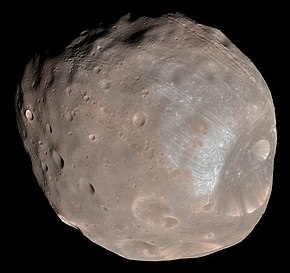
Back Fobos (maan) Afrikaans Phobos (satelite) AN فوبوس Arabic ফ'বছ (উপগ্ৰহ) Assamese Fobos Azerbaijani فوبوس (قمر) AZB Фобос Bashkir Phobos (Mond) BAR Фобас (спадарожнік Марса) Byelorussian Фобас BE-X-OLD
 Enhanced color image of Phobos, as captured by the Mars Reconnaissance Orbiter. Stickney, the largest crater on Phobos, is on the right. | |
| Discovery | |
|---|---|
| Discovered by | Asaph Hall |
| Discovery date | 18 August 1877 |
| Designations | |
Designation | Mars I |
| Pronunciation | /ˈfoʊbɒs/[1] or /ˈfoʊbəs/[2] |
Named after | Φόβος |
| Adjectives | Phobian[3] /ˈfoʊbiən/[4] |
| Orbital characteristics | |
| Epoch J2000 | |
| Periapsis | 9234.42 km[5] |
| Apoapsis | 9517.58 km[5] |
| 9376 km[5] (2.76 Mars radii/1.472 Earth radii) | |
| Eccentricity | 0.0151[5] |
| 0.31891023 d (7 h 39 m 12 s) | |
Average orbital speed | 2.138 km/s[5] |
| Inclination | 1.093° (to Mars's equator) 0.046° (to local Laplace plane) 26.04° (to the ecliptic) |
| Satellite of | Mars |
| Physical characteristics | |
| Dimensions | 25.90 km × 22.60 km × 18.32 km (± 0.08 km × 0.08 km × 0.06 km)[6] |
Mean radius | 11.08±0.04 km[6] |
| 1640±8 km2[6] | |
| Volume | 5695±32 km3[6] |
| Mass | 1.060×1016 kg[7] |
Mean density | 1.861±0.011 g/cm3[6] |
| 0.0057 m/s2[5] (581.4 µg) | |
| 11.39 m/s (41 km/h)[5] | |
| Synchronous | |
Equatorial rotation velocity | 11.0 km/h (6.8 mph) (at longest axis) |
| 0° | |
| Albedo | 0.071 ± 0.012 at 0.54 μm[8] |
| Temperature | ≈ 233 K |
| 11.8[9] | |
Phobos (/ˈfoʊbəs/; systematic designation: Mars I) is the innermost and larger of the two natural satellites of Mars,[10] the other being Deimos. The two moons were discovered in 1877 by American astronomer Asaph Hall. It is named after Phobos, the Greek god of fear and panic, who is the son of Ares (Mars) and twin brother of Deimos.
Phobos is a small, irregularly shaped object with a mean radius of 11 km (7 mi).[5] Phobos orbits 6,000 km (3,700 mi) from the Martian surface, closer to its primary body than any other known natural satellite to a planet. It orbits Mars much faster than Mars rotates and completes an orbit in just 7 hours and 39 minutes.[11] As a result, from the surface of Mars it appears to rise in the west, move across the sky in 4 hours and 15 minutes or less, and set in the east, twice each Martian day.
Phobos is one of the least reflective bodies in the Solar System, with an albedo of 0.071. Surface temperatures range from about −4 °C (25 °F) on the sunlit side to −112 °C (−170 °F) on the shadowed side.[12] The notable surface feature is the large impact crater, Stickney, which takes up a substantial proportion of the moon's surface. The surface is also home to many grooves, with there being numerous theories as to how these grooves were formed.
Images and models indicate that Phobos may be a rubble pile held together by a thin crust that is being torn apart by tidal interactions.[13] Phobos gets closer to Mars by about 2 cm per year, and it is predicted that within 30 to 50 million years it will either collide with the planet or break up into a planetary ring.[12]
- ^ "Phobos". Lexico UK English Dictionary. Oxford University Press. Archived from the original on 2 March 2020.
- ^ "Moons of Mars – the Center for Planetary Science".
- ^ Harry Shipman (2013) Humans in Space: 21st Century Frontiers, p. 317
- ^ The Century Dictionary and Cyclopedia (1914)
- ^ a b c d e f g h "Mars: Moons: Phobos". NASA Solar System Exploration. 30 September 2003. Archived from the original on 19 October 2013. Retrieved 2 December 2013.
- ^ a b c d e f Cite error: The named reference
Ernst2023was invoked but never defined (see the help page). - ^ Pätzold et al. (2014), as cited in Ernst et al. (2023).[6]
- ^ Clark, Beth Ellen (March 1998). Near Photometry of C-Type Asteroid 253 Mathilde (PDF). 29th Lunar and Planetary Science Conference. Lunar and Planetary Institute. Retrieved 27 April 2023.
- ^ "Mars' Moons".
- ^ "Mar's moon Phobos". NASA. Retrieved 16 July 2016.
- ^ "ESA Science and Technology - Martian moons: Phobos". ESA. Retrieved 5 July 2023.
- ^ a b "NASA – Phobos". Solarsystem.nasa.gov. Archived from the original on 24 June 2014. Retrieved 4 August 2014.
- ^ Zubritsky, Elizabeth (10 November 2015). "Mars' Moon Phobos is Slowly Falling Apart". NASA. Retrieved 19 July 2021.